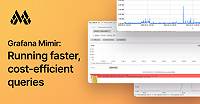Important: This documentation is about an older version. It's relevant only to the release noted, many of the features and functions have been updated or replaced. Please view the current version.
Migrate ingesters to spread-minimizing tokens
Using this guide, you can configure Mimir’s ingesters to use the spread-minimizing token generation strategy.
Before you begin
The ingester time series replication should be configured with enabled zone-awareness.
Note
Spread-mimizing tokens are recommended if shuffle-sharding is disabled on the write path of your ingesters, or, if it is enabled, but most of the tenants of your system use all available ingesters.
Note
In order to prevent incorrect query results, shuffle-sharding on the read path of your ingesters must be disabled before migrating ingesters to the spread-minimizing tokens. Shuffle-sharding on ingester’s read path can be re-enabled at least
-querier.query-store-aftertime after the last ingester zone was migrated to the spread-minimizing tokens.
If ingesters are configured with a non-empty value of -ingester.ring.tokens-file-path, this is the file where ingesters store the tokens at shutdown and restore them at startup. Keep track of this value, because you need it in the last step.
For simplicity, let’s assume that there are three configured availability zones named zone-a, zone-b, and zone-c. Migration to the spread-minimizing token generation strategy is a complex process performed zone by zone to prevent any data loss.
Step 1: Disable write requests to ingesters from zone-a
To disable write requests, configure the following flag on the distributor and the ruler:
-ingester.ring.excluded-zones=zone-aBefore proceeding to the next step, use the following query to ensure that there are no write requests to the ingesters from zone-a:
sum by(route) (
rate(
cortex_request_duration_seconds_count{
namespace="<your-namespace>",
container="ingester",
pod=~"ingester-zone-a-.*",
route="/cortex.Ingester/Push"}[5m]
)
)You should see something like this:

Step 2: Shut down ingesters from zone-a
Next, ensure that all the in-memory series of all ingesters from zone-a have been flushed to long-term storage, as well as that the ingesters from zone-a have been forgotten from the ring.
To do this, invoke the /ingester/shutdown endpoint on all the ingesters from zone-a.
Before proceeding to the next step, ensure that all the calls completed successfully completed.
Step 3: Enable spread-minimizing tokens for ingesters in zone-a
Configure the following flags on the ingesters from zone-a:
-ingester.ring.tokens-file-path=
-ingester.ring.token-generation-strategy=spread-minimizing
-ingester.ring.spread-minimizing-zones=zone-a,zone-b,zone-cNote
The example uses
zone-a,zone-b,zone-cto denote a comma-separated list of configured availability zones.
Before proceeding to the next step, ensure that all the ingester pods related to zone-a are up and running with the new configuration.
Optional step: In-order registration of ingesters
Mimir can force the ring to perform an in-order registration of ingesters. When this feature is enabled, an ingester can register its tokens within the ring only after all previous ingesters (with ID lower than its own ID) have already been registered. This feature minimizes a probability that a write request that should be handled by an ingester actually arrives to the ring before the ingester is registered within the ring. In this case, the request gets handled by another ingester. This situation could introduce some deviation from an optimal load distribution.
To configure this capability:
-ingester.ring.spread-minimizing-join-ring-in-order=trueStep 4: Re-enable write requests to ingesters from zone-a
To re-enable write requests, revert link Step 1: Disable write requests to ingesters from zone-a.
At this point, you can check the number of in-memory time series of ingesters from zone-a using the following query:
sum by(pod) (
cortex_ingester_memory_series{
namespace="<your-namespace>",
pod=~"ingester-zone-a-.*"}
)If everything went smoothly, you should see something like this:

Step 5: Migrate ingesters from zone-b
Repeat steps 1 to 4, replacing all the occurrences of zone-a with zone-b.
Step 6: Migrate ingesters from zone-c
Repeat steps 1 to 4, replacing all the occurrences of zone-a with zone-c.
Step 7: Delete the old token files
If, before the migration, you configured ingesters to store their tokens under -ingester.ring.tokens-file-path, you must delete these files after migrating all ingester zones to spread-minimizing tokens.
For example, if an ingester pod called ingester-zone-a from a namespace called mimir-prod used to store its tokens in a file called /data/tokens, you can run the following command to delete the /data/tokens file:
kubectl -n mimir-prod exec ingester-zone-a-0 -- rm /data/tokens

